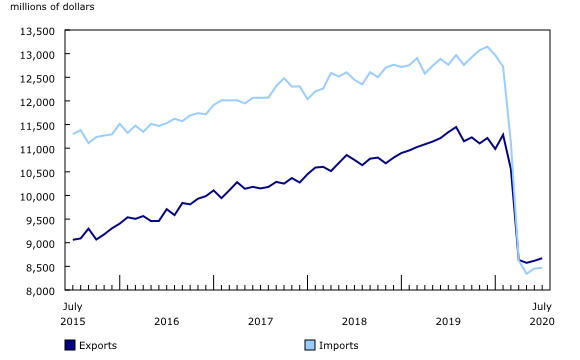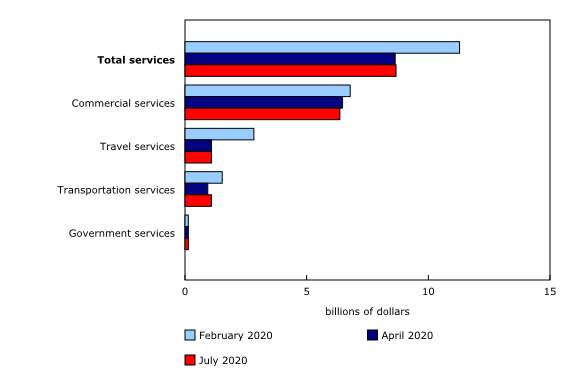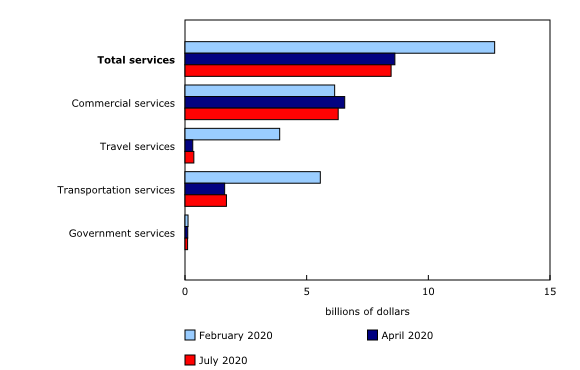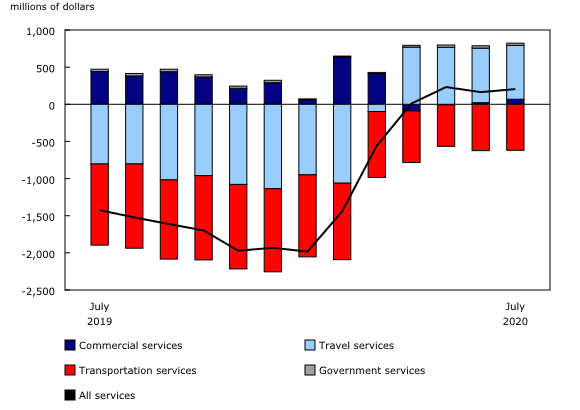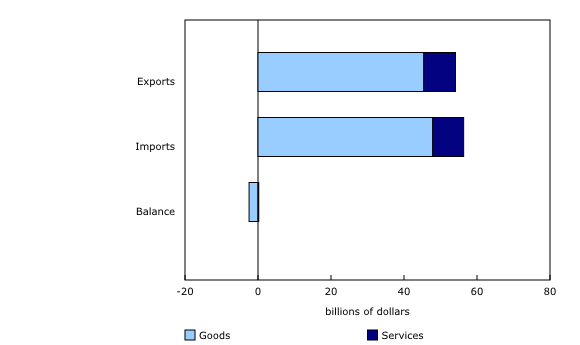Canadian international trade in services, July 2020
Archived Content
Information identified as archived is provided for reference, research or recordkeeping purposes. It is not subject to the Government of Canada Web Standards and has not been altered or updated since it was archived. Please "contact us" to request a format other than those available.
Released: 2020-09-03
Canada's monthly international trade in services surplus increased from $164 million in June to $204 million in July. Overall, exports of services increased 0.6% to $8.7 billion and imports edged up 0.2% to $8.5 billion.
Exports of transportation services rose 9.3% to $1.1 billion in July because of increased international trade in goods activity, as COVID-19-related restrictions on businesses in Canada continued to be loosened. Partially offsetting the increase was a 0.5% decrease in exports of commercial services, which dropped to $6.4 billion mainly on lower exports of financial services. Exports of travel services edged down 0.1% to $1.1 billion. COVID-19-related international travel restrictions remained in place for visitors to Canada in July.
Imports of transportation services increased 5.3% to $1.7 billion in July, almost entirely because of components other than passenger fares. Imports of commercial services were down 1.3% to $6.3 billion. As with exports, the decline was the result of lower imports of financial services, as imports of non-financial services recorded a slight increase in July. The declines in both the import and export of financial services were related to lower volumes of cross-border activity on financial markets in July.
In July, exports of travel services were still 61.5% lower than they were in February, while exports of transportation services were 29.1% below their February levels. For imports, the corresponding values in July were 90.7% below February levels for travel services and 33.5% below February levels for transportation services. Travel restrictions and border closures related to COVID-19 have contributed to keeping travel services and the passenger fares component of transportation services at lower levels, while other types of international trade—in particular trade in goods—have posted strong gains since June.
In comparison, total imports of goods increased 12.7% to $47.9 billion in July, while total exports of goods rose 11.1% to $45.4 billion, resulting in a goods deficit of $2.5 billion. When combined, the trade balance for goods and services amounted to a deficit of $2.2 billion in July—a decrease of $779 million from June.
Exports of services for June were revised up by $566 million, almost entirely on an increase in commercial services. Imports of services were revised down by $325 million, as a downward revision to travel services was partially offset by an upward revision to commercial services. This month's release reflects the integration of quarterly benchmark data from the balance of payments for the second quarter of 2020, as well as revisions to the first quarter of 2020.
Note to readers
Adjustments to the methodological approach
Circumstances surrounding COVID-19 pose issues for the production of the monthly international trade in services statistics, particularly for travel and transportation services.
Travel services and the passenger fares component of transportation services are estimated using tourist and traveller counts as indicators of monthly movement. These data are not available on a timely basis and are projected for the reference month before being replaced by the actual values in the following month. This approach works in a typical month, but does not work in the current situation in which travel restrictions that reduce tourist and traveller numbers have been implemented very rapidly.
To better capture the effects of the COVID-19 pandemic, Statistics Canada is incorporating data from the Canada Border Services Agency's primary inspection kiosks into its monthly international trade in services program. These kiosk are electronic customs declaration kiosks that have been installed in most major Canadian airports. While these data represent only a subset of total travellers, they provide relevant and timely insights.
In addition, the methodology used for the estimation of the monthly international trade in services statistics involves first projecting quarterly benchmark values, then dividing these quarterly values into monthly values using economic indicators. While the projected quarterly value was previously kept constant by producing data for all three months of the quarter, with the current volatility, this particular element of the model was revised and the benchmark values are being adjusted based on the most current data, as needed.
Revisions
Because of the unprecedented circumstances related to the COVID-19 pandemic, larger-than-normal revisions may occur in subsequent months, as additional—but less timely—indicator data are incorporated into the monthly services program.
With this month's release, the seasonal adjustment models for the components other than education-related travel services have been revised and improved to become less reliant on expected trend estimates.
Methodology
Because several data sources used to compile the international trade in services program are only available on a quarterly or annual basis, the monthly statistics on Canada's international trade in services are generated using models when up-to-date information is not available. This follows the methodology used in many countries that produce monthly trade in services data.
In general, for most commercial and travel services, as well as some transportation services, the modelling of monthly estimates follows a three-step approach. First, values for the upcoming quarter are estimated using statistical models (auto-regressive integrated moving average). Second, indicator series that proxy the monthly movement of trade in services are identified through relationships with other economic indicators, such as merchandise trade or gross domestic product by industry. Third, a temporal disaggregation method (the Denton-Cholette method) is applied to distribute modelled quarterly services on a monthly basis, using the predicted values of monthly services generated in the second step. Adjustments are made each month as new information becomes available.
A more detailed description of the estimation methodology used for monthly trade in services is available upon request.
Products
The updated Canada and the World Statistics Hub (13-609-X) is available online. This product illustrates the nature and extent of Canada's economic and financial relationship with the world using interactive graphs and tables. This product provides easy access to information on trade, investment, employment and travel between Canada and a number of countries, including the United States, the United Kingdom, Mexico, China, Japan, Belgium, Italy, the Netherlands and Spain.
The Methodological Guide: Canadian System of Macroeconomic Accounts (13-607-X) is available.
The User Guide: Canadian System of Macroeconomic Accounts (13-606-G) is also available. This publication will be updated to maintain its relevance.
Contact information
For more information, contact us (toll-free 1-800-263-1136; 514-283-8300; STATCAN.infostats-infostats.STATCAN@canada.ca).
To enquire about the concepts, methods or data quality of this release, contact Alec Forbes (613-668-6454; alec.forbes@canada.ca), International Accounts and Trade Division.
- Date modified:



